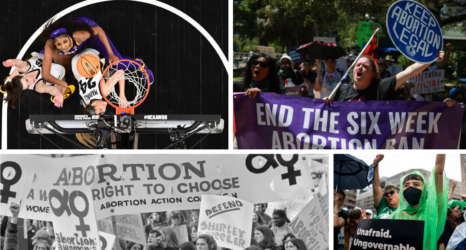Found dead on January 4 in Canton, Mississippi, Mesha Caldwell, a black 41-year-old trans woman, was the first trans person killed in 2017. Three days later, 28-year-old two-spirit trans woman Jamie Lee Wounded Arrow was killed in Sioux Falls, South Dakota. Both killed before even a full week had passed in 2017, Caldwell and Wounded Arrow are two of too many trans lives lost to brutal acts of violence across the country this year—the deadliest on record for the trans community.
At least 23 transgender people have been killed this year, most of them women and people of color. And there are likely many more whose murders have gone unreported or misreported.
Chay Reed, a 28-year-old black trans woman, was killed in Miami, Florida. Keke Collier, a 24-year-old black trans woman, was killed in Englewood, Chicago. JoJo Striker, 23, was killed in Toledo, Ohio. Alphonza Watson was killed at 38 in Baltimore, Maryland; Jaquarrius Holland at 18 in Monroe, Louisiana. Ciara McElveen was 21 years old when she was stabbed to death in New Orleans, Louisiana. Chyna Gibson was 31 when she was shot and killed in the same city. 30-year-old black trans woman Kiwi Herring was killed in St. Louis, Missouri. Gwynevere River Song, a 26-year-old who identified as femandrogyne and used they/them prononouns, was killed in Waxahachie, Texas. TeeTee Dangerfield, a 32-year-old black trans woman, was killed in Atlanta, Georgia. Ebony Morgan, a 28-year-old black trans woman, was killed in Lynchburg, Virgina. 17-year-old black trans woman Ava Le’Ray Barrin was killed in Athens, Georgia. At 28, Josie Berrios, also known as Kendra Adams and Kimbella Rosé for her drag performances, was killed in Ithaca, New York. Kenne McFadden, a 27-year-old black trans woman, was found dead in San Antonio, Texas. Sherrell Faulkner, a 46-year-old black trans woman, was attacked in November of last year and died this May in Charlotte, North Carolina; Kenneth Bostick, a 59-year-old homeless black trans man struggling with mental illness, was attacked in April and died the same month in New York City.
Most recently, Candance Towns, a 30-year-old black trans woman from Macon, Georgia, was found dead on October 31; she had been shot to death. A few days earlier, the body of Stephanie Montez—a 47-year-old transgender woman killed by multiple gunshot wounds—was found in Robstown, a suburb of Corpus Christi, Texas. Two months before, 17-year-old Ally Lee Steinfeld was reported missing; three weeks later, her remains were found in Cabool, Missouri. Around that same time, 26-year-old Derricka Banner—described as a playful spirit and a “go-getter” by her friends—was killed in Charlotte, North Carolina, and 28-year old black transgender man Kashmire Redd was killed in Gates, New York.
At least 19 trans women were killed in 2016. At least 22 trans women were killed in 2015. Trans women, and particularly trans women of color, have bore the brunt of transmisogynist hate with their bodies—and lost their lives daring to defy it—for too long. A multi-year study by the National Coalition of Anti-Violence Programs confirmed that trans women face a heightened risk of death by hate violence in comparison to other groups; living at the intersections of transphobia, racism, sexism and criminalization has also led trans women of color to disproportionately face high rates of poverty, unemployment and homelessness.
Due to the violence and harassment they face, trans and non-binary folks of color are also particularly prone to mental health issues such as major depression and prolonged anxiety; living as disabled and trans presents, for them, even more tangible dangers. Scout Schultz—a Georgia Tech student that identified as non-binary and used they/them pronouns—was killed by police with no intervention training while they were experiencing a mental health crisis. Sean Hake—a 23-year-old transgender man—was killed by police in Sharon, Pennsylvania while attempting to harm himself. Police in Mesa, Arizona shot and killed Kayden Clarke—a 24-year-old transgender man with Asperger syndrome—after his friend informed he police that Clarke was suicidal.
Although the epidemic of anti-trans violence isn’t news, the disappointing annual increases in lives lost show that policy and rhetoric matter. The trans individuals killed in 2017 lost their lives amid a backdrop of anti-trans attacks fueled, in part, by lawmakers. This year, the Trump administration axed protections for trans students, attempted to ban trans people from serving in the military, and tried time and time again to restrict trans access to healthcare; across the country, state and local lawmakers also attempted to codify discrimination with anti-trans “bathroom bills” and other measures meant to isolate and harm trans communities. In many states, trans people even lack legal protections based on their gender identity: 20 states do not classify acts of anti-trans violence as hate crimes, and 4 states have no hate crime laws at all.
“Under Texas law, it’s not a hate crime [to kill a trans person],” Kathy Huff, President of Parents and Friends of Lesbians and Gays (PFLAG) Corpus Christi Chapter, said at a rally held in the wake of Stephanie Montez’s murder, calling the crowd to action to fight for change. “We’re sons, daughters, nieces and nephews. We have lives, hopes and dreams.”
2015 was called the deadliest year on record for trans people. So was 2016. The epidemic of anti-trans violence has once again reached a tragic peak—and it is long past time that lawmakers work to stymy it and stop attempting to fuel it.





